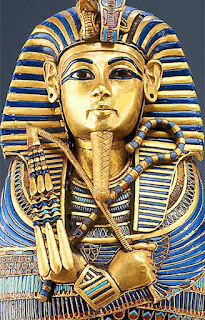



These fabulous trappings consist of eight golden mummy bands used instead of linen to hold the final layer of bandages in place, a pair of eerily life-like golden hands gripping a crook and flail, a scarab hung from a gold chain, and an exquisite pectoral in the shape of a human-headed bird.
Mummy Bands
The cartouches - king's names - had been cut out of King Tut's mummy bands
Each mummy band is a series of plaques decorated with hieroglyphs inlaid in coloured glass. The texts carry the names of the king and include protective spells spoken by different deities such as the sky goddess Nut, the embalming god Anubis, and the Four Sons of Horus who guard the king's viscera - the life sustaining organs he would need in the Afterlife.
Interestingly, Carter found that most of the cartouches (the king's names) on the underside of these bands had been cut out and replaced with plain gold. One that had not been removed was Anakheperure, the co-regent of Tutankhamun's successor and, it is believed, Tutankhamun's brother. This treatment of the bands reinforces the view that the burial arrangements for the boy king were very hurried as a result of his unexpected death.
Final Grasp
The royal hands are of burnished gold with wrist lets of colored glass and carnelian. The crook and flail, emblems of royal authority and power, are made of silver cores covered with alternating bands of glass and gold, and the resin scarab is inscribed with a protective spell from the Book of The Dead.
External Trappings of Tutankhamun's Mummy (Shot in King Tut Virtual) VIDEO: External Trappings of Tutankhamun's Mummy (Shot in King Tut Virtual)
Perhaps the most striking piece is the human-headed bird, representing ba. This is the part of the human soul believed to fly from the body at the instant of death, and thus identified with breath and movement. For a person to be resurrected properly, essential before the Afterlife can be entered, the ba must be reunited with the body and with ka, the vital and unique life-force of the individual.
This ba pectoral is made of gold inlaid with glass to mimic turquoise, lapis lazuli and carnelian. The bird’s claws grip shen signs, rings symbolizing the eternal circuit of the sun. The human face of this beautiful piece is rendered with exquisite sensitivity.
The King's Headdress
Worn by the king in life? - Perhaps. Worn by the king in death? - Certainly. This beautifully simple diadem was found in place on the king's mummy over a beaded skullcap covering his shaved head. Made expressly for the king, the diadem is comprised of a solid gold headband inlaid with lapis and lazuli-colored glass and set with circles of carnelian-colored glass, each with a central gold boss. The headband is closed by a symmetrical bow-shaped clasp made of a sun disk of chalcedony flanked by papyrus flowers inlaid with malachite. The four "streamers" extend from the headband, decorated to match the headband, two of which are flanked by rearing uraei (snakes).
The uraeus and vulture had been placed in the wrappings over the king's thighs since there was insufficient room for them beneath the golden mask. Sockets allowed them to be placed in front of the headband with the body and tail of the uraeus retaining the shape of the diadem and holding it in place on the king's head. The snake head is made of dark blue faience, the upper body of chased gold. The vulture's head is of gold with eyes of obsidian. These creatures represent the patron goddesses of Upper and Lower Egypt, attesting to the king's dominion over the two lands.
The Centerpiece
The spectacular golden mask of Tutankhamun is the most iconic image of the ancient world. Instantly recognizable, compellingly beautiful and deeply mysterious. But it wouldn’t have shone quite as brightly at the time of the discovery. The resinous material used during mummification had, over time, hardened and blackened into a kind of sticky tar. This residue had also stuck the death mask to the king's head and shoulders, making it impossible to safely remove. After several failed experiments, Carter used hot knives to cut the mask free, severing the mummy's head in the process.
No doubt this macabre event contributed to the legend of a curse which it is claimed led to the deaths of many of those involved in the excavation.
The craftsmen who created this masterpiece began by hammering together two thick sheets of gold, thought to echo the flesh of the gods. These were then shaped into the likeness of the king, who is portrayed wearing the striped nemes headdress. On the shoulders and back of the mask a magical text refers to the different parts of the body and their connection to particular deities. These serve to protect the king's body and render it functional for immortality. Silent though it is, the mask speaks across the centuries of wonderful skill, amazing wealth and a profound belief in the Afterlife.




No comments:
Post a Comment